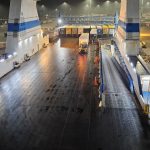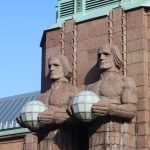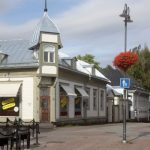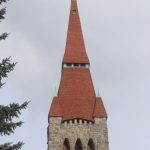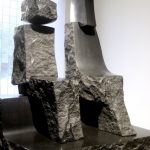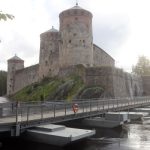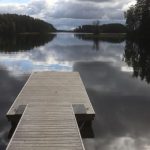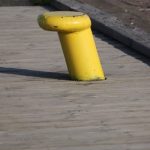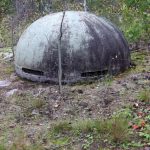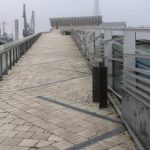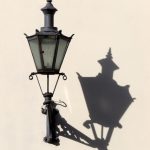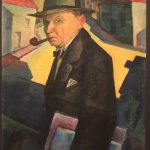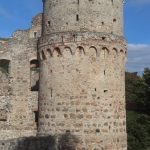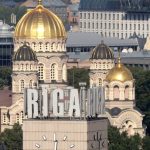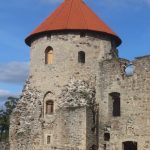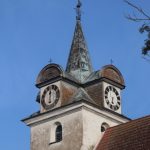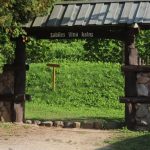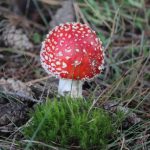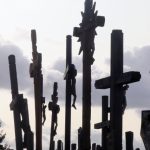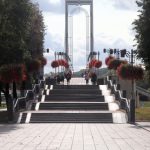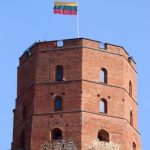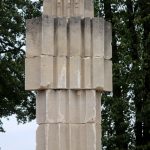In September/October 2023 we finally embarked on a long-planned trip to the Baltic Republics, Estonia, Latvia and Lithuania. In order to reduce the amount of driving involved we had decided that we would take a ferry on the way out. As the nearest ferry to us leaves from Northern Germany, and docks in Helsinki, we opted for an extra week in Finland, technically not really the Baltics, but close. This blog covers the entire trip, from the first ferry crossing to Helsinki to the last stop in Gdansk, Poland, on the way home. Quite a varied program, although cities did play an important part in the itinerary.
An area we have never yet explored is the entire North and Northeastern Europe. It would be nice to combine this whole area in one trip – it is easy to imagine circling the Baltic Sea (what we call ‘Oostzee’ – East Sea – in Dutch) clockwise or anti-clockwise. Piece of cake really, except that we are time-limited, we have four weeks only. Which is not enough.
So we compromise, and limit ourselves to the Baltics, for starters. Read more.
02. the ferry
Somehow, we spend an inordinate amount of time on an inordinate number of ferries, lately. Just three weeks ago we took a boat to Newcastle, for a few week’s travel in Scotland, which also included the Orkney Islands – only to be reached by more ferries, indeed. And now we board the Finnmaid, a huge ferry that takes us in a little over 30 hours from the German port of Travemunde to Helsinki. Comfortable, a very relaxed way of traveling. Except that we leave in the middle of the night, 2 am, but that is only a minor inconvenience. Read more.
03. Helsinki
Having decided last minute to travel via Helsinki to the Baltics, we haven’t prepared ourselves very well. The only thing I have read so far was a brief account of a Dutch travel writer, who assessed that there was really nothing to do in Helsinki.
How wrong! Helsinki is a fabulous city. Read more.
04. the Finnish history
For most of its history, Finland was dominated by its neighbours. Read more.
05. Turku
We probably could have spent another day in Helsinki, there are lots of other places to admire, too. But the weather forecast for Turku, in the west of the country, was much better. And Turku is only two hours away. Read more.
06. Rauma
Where we had just seen the ‘wooden houses museum’ in Turku, a group of well preserved and well protected over 200 year old wooden houses, Rauma has the real thing. The centre of the old town is entirely made up of wooden houses, still being used, as residences and as shops and restaurants. Most are ground floor-only, occasionally there is a second floor; most are simple affairs, with simple windows and simple doors, but often neatly adorned, with a lace curtains or decorative items in the window sills. There are clearly people living here. Read more.
07. the churches
We have already seen a few curious churches, amongst them the dug-out Temppeliaukio Kirkko in Helsinki and the spectacularly modern-design St. Henry’s Ecumenical chapel outside Turko. But now we are in for some more traditional countryside churches, as well as the fabulous cathedral in Tampere, taking us back to the Art Nouveau era. Read more.
08. the museum
The Gösta Serlachius Museum, in Mantta, is heralded as the best art museum in Finland. Started as a private collection by the papermill owning industrialist Serlachius family over a century ago, the first museum opened in 1945, I suppose in the manor house that still forms the heart of the museum. In 2014 a new wing was added, starkly attractive modern architecture again, in wood, to provide more exhibition space for what is by now an impressive collection. Read more.
09. Savonlinna
There are more paintings to be seen in Finland, but of another nature. Before I came to Finland I had no idea that they have rock art here, paintings executed on rock faces perhaps 5000 years ago. Read more.
10. the lake district
If Finland is the land of lakes and forest, today we have seen Finland. Half an hour outside Savonlinna is the Punkaharju area, where we are driving across a narrow land tongue, or perhaps it is an artificial dam, with lakes on both sides. It is quite nice weather, which helps appreciating the landscape – and helps in the photos, too. Read on.
11. Lappeenranta
At the far end of the Saima Lake Lappeenranta is barely 25 km from the Russian border, and somehow the town feels more Russian than any other town we have so far seen in Finland. Broad, empty roads, lined with the ubiquitous apartment buildings. Not as destitute as we have observed in so many ex-Soviet republics, or indeed in many Eastern European countries, but they show an uncanny similarity with what we call the palatis. Read on.
12. the Salpa Line
The Salpa Line is a string of defensive fortifications built by the Finnish army after having lost their first war against the Soviet Union, the Winter War of 1939-1940. Read on.
13. to Poorvo
On the way to Poorvo we also briefly stopped in Kotla, to admire the building of the local Maritime museum, called Vellamo, which is supposed to represent a wave of steel and glass. Weather had turned ugly again, so pictures are poor, but the building in indeed a tribute to architectural ingenuity. With from one side a walking path from ground level all the way to the roof, and on the other a metal construction that indeed resembles a breaking wave. No time to go inside, but a quick glance shows that here, too, the design is revolutionary. Read on.
14. Tallinn
Already on the ferry the differences between Finland and Estonia became clear. Chatty Estonians strike up a conversation, offer help where we have language difficulties, and are generally extrovert and friendly. Read on.
15. the KUMU
The KUMU, short for Kunsti Museum (which is Estonian for Museum of Art) in Tallinn, is one of Estonia’s largest museums, and as far as we were concerned – subjectively, I know – its most appealing. It starts with the strikingly modern building, opened in 2006. This is for the most filled with paintings, and some other works, of Estonian artists – a few from the more classical mid-19th century, but mostly more modern painters, late 19th and right through the 20th century. Read on.
16. the islands
Apparently, nobody knows how many islands Estonia has, exactly. There is a list counting 2355, but I imagine that many are small and uninhabited. Saaremaa is the largest, and to get to Saaremaa, you have to go through another island, Muhu. A good start. Read on.
17. Tartu
All the way to Tartu, towards the east and quite close to the Russian border, the weather remains miserable. We bypass Parnu, a fairly important town at the Gulf of Riga, part of the Baltic Sea, and reputedly also a popular local tourist destination; we couldn’t find much of interest to us, here. Read on.
18. into Latvia
An hour or so after we leave Tartu we enter Latvia, through the border town of Valga. And it shows, the difference is striking. Not so much in the countryside before and after, which is flat, lots of woods, the occasional farmland, and not very attractive. But the roads deteriorate notably, the towns we pass through look a lot poorer… Read on.
19. Riga
There are two parts of Riga that are of interest to the casual visitor, or three, actually. The big two are Central Riga, with its long, straight streets lined with Art Nouveau buildings, and Old Riga, the old town with its cobbled, twisted and turning alleys, and chaotic mix of architectural styles. Read on.
20 Riga (2)
Earlier I mentioned a third area of interest, beyond Central Riga and Old Riga, and this is the area south of the Old Town. Here is the Central Market, a sprawling complex covering five huge German-built halls to store the infamous WWI zeppelins. When the market was moved to its current location in 1930, the government decided to bring in those hangars from elsewhere in Latvia, which now form the heart of what is claimed to be the biggest market in Europe; Read on.
21. some Baltic history
So let’s summarise that Baltic history a bit. A few years ago, reading up about Ukraine trying to understand recent developments there, I was astounded to find that the western half of Ukraine had been part of a Lithuanian empire. We are talking 14th Century, when Lithuania stretched from the Baltic Sea to the Black Sea, initially on its own, and later, through marriage, together with Poland, which became an ever more dominant partner in the coalition.
But by the 16th C Russian influence became tangible,… Read on.
22. the bog
After a few days city exploration it was time for some nature again. Outside Riga is the Kemeri bog, a kind of wetland resulting from the differential filling in of post-glacial valleys, which ultimately led to an area full of small lakes, called bog pools. The area is part of a national park, and has been developed to allow visitors to see the pools while keeping dry feet;… Read on.
23. Kuldiga
We only came to sleep in Kuldiga, well, and maybe check out a thing or two. But what a lovely town this is. High percentage of cobbled streets, high percentage of well-maintained wooden houses, lots of flowers in the windows, and along the roads, and autumn colours providing the extra touch. Read on.
24. Sabile
Sabile is home to the Pedvāle Art Park. This sculpture garden was founded by Ojars Feldbergs, a Latvian sculptor, who not only sculpts, but also arranges symposiums and workshops where other sculpturers from all over the world sculpt – and their collective production is being exhibited in the garden. Read on.
25. Liepaja
Liepaja was not in the plan, but our Latvian friend suggested we go here (and I do listen to others, occasionally). And we didn’t regret it. For starters, I have been going on about wooden houses for a while now, and guess what? The apartment we booked in Liepaja was in one of those wooden houses. Brilliant experience, a comfortable modern-fitted apartment, reached by rickety wooden stairs and a dark corridor, shared with other apartments. Read on.
26. the Curonian Spit
I had to look it up, too, but the Curonian Spit is the name an almost 100 km long, thin dune-covered sand bank that separates a lagoon from the Baltic Sea. About half of it is Lithuanian territory, the rest is Russian, part of Kaliningrad. Read on.
27. the crosses
We didn’t spent much time in Klaipeda. Our first experience in Lithuania was a little disappointing. Saturday night was deserted, hardly anybody in the streets, the town was dead. Sunday morning we did a fleeting tour of the city, by car through the centre – admittedly, not a very balanced approach, but there seemed little of interest. Most of what we saw looked pretty run-down.
The excitement came a little later… Read on.
28. Kaunas
The young host of our B&B was very enthusiastic about Kaunas, and convinced us not only to have a look at the Old Town, what all the tourists do, but also concentrate on the Art Deco buildings, which sprang up in the newer part of the town from the 1920s onwards. Although Lithuania gained its independence from Russia in 1918, its capital Vilnius, was soon afterwards occupied by the Poles, in fact all the way to WWII. Kaunas then served as the interim capital, which led to a construction boom to bring the city up to the standards of a European capital city. Read on.
29. Vilnius
Vilnius is considered one of the best preserved old towns of Europe, ‘old’ meaning medieval. It was established in 1323 and grew to become the capital of the Grand Duchy of Lithuania, which stretched from the Baltic to the Black Sea, including large parts of Belarus and Ukraine, and even Russia. However, its biggest expansion period was the 16th century, when the walls were built, the nine gates – of which one is left -, the palace of the Grand Dukes and the university. And much of the old town seems to date from this time, or a little later, demonstrating a distinctive baroque architecture. Read on.
30. the Museum of the Centre of Europe
I am not sure that the claim of this museum, also known as Europos Parkas, to be the centre of Europe is geographically entirely correct – although, apparently, the French National Geographic Institute has, in 1989, determined so. But in any case, at about half an hour’s drive north of Vilnius this this is a wonderful open-air museum, or rather a sculpture park, with over a hundred works seemingly randomly distributed across a 55 hectare forest. Read on.
31. Druskininkai
Druskininkai is a small Lithuanian town in the far SE corner of the country, near the Belarus border. It is insignificant, except that it has somehow developed in the spa capital of Lithuania. “Druska” is Lithuanian for salt, and refers to salt springs that apparently form the basis for this development, although I have seen no hotels advertising a link to authentic spring water. Yet, each and every hotel seems to have a spa and sauna and massage and whatever else. Read on.
32. Gdansk
Although not in the Baltics, Gdansk is on the Baltic Sea, and on the way home, so we decided to stop here for a day. A bonus, so to speak.
Entering Poland from Lithuania is a difference of night and day. Once across the border, we realise how poor Lithuania actually is. In Poland the roads are better, the houses are better, life seems to be much more prosperous. Read on.


